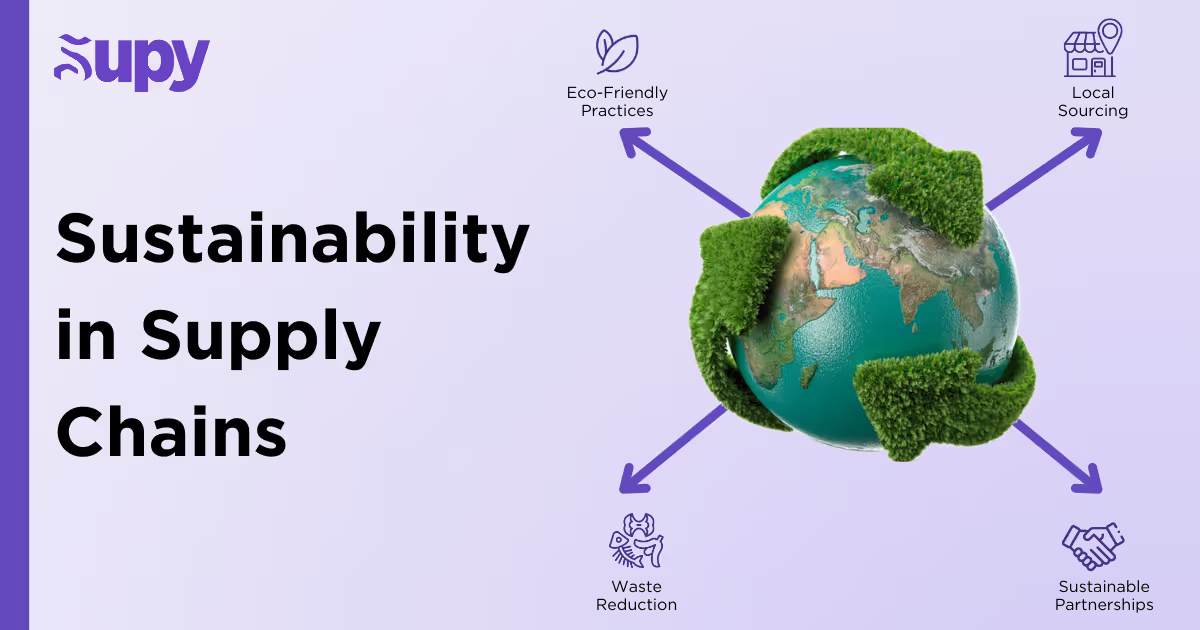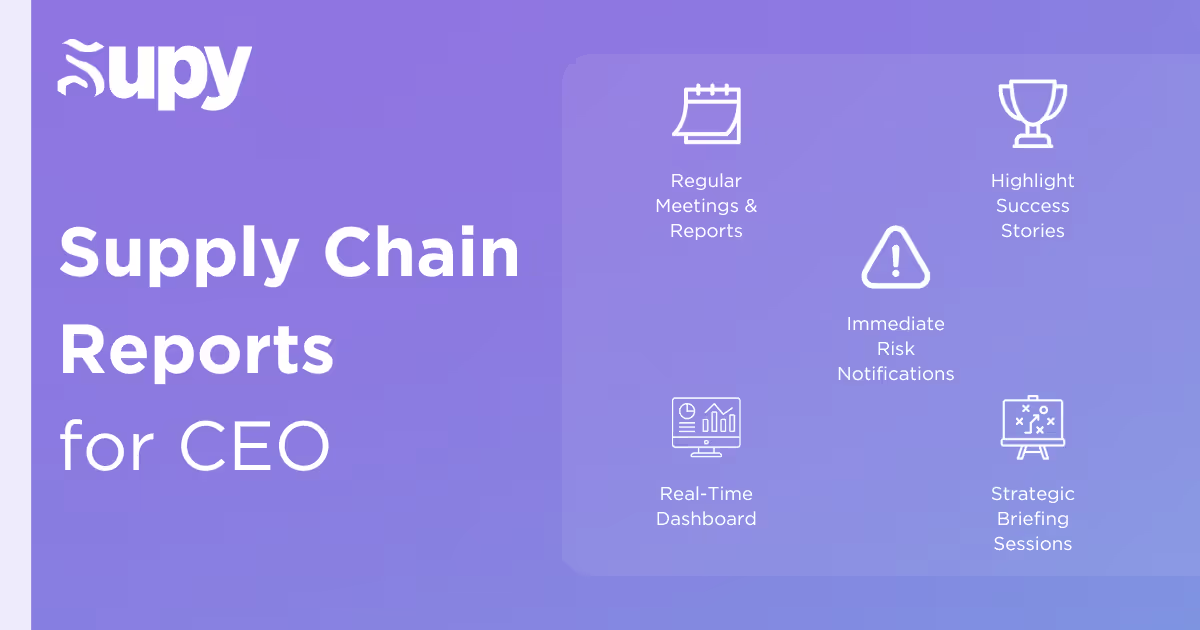The Top 5 Ways to Impress Your CEO as a Supply Chain Director

Supply chain management (SCM) is fundamental to any business, especially in the food and beverage sector, where timing, quality, and cost significantly impact success. As a Supply Chain Director, you manage the flow of goods and ensure that every component from farm to table is optimized for efficiency and quality.
Facing challenges such as fluctuating demand, volatile supply costs, and the constant need for speed and efficiency, your decisions don't just solve problems—they set the stage for growth and innovation. And no one understands this better than your CEO, who relies on your expertise to navigate these waters smoothly. In recognizing and overcoming these hurdles, you uphold the supply chain’s integrity and strengthen your reputation as a key player in your company’s leadership.
In this blog, we’ll look at:
- Analyze Data to Drive Better Decisions
- Enhance Supply Chain Transparency
- Improve Cost Efficiency
- Promote Sustainability Initiatives
- Stay Ahead of Market and Supply Trends
- Keep Your CEO Engaged and Informed
- Conclusion
- About Supy
Let's see how you can take the right steps to improve your supply chain strategy, helping you impress your CEO and affirm your role among supply chain leaders.
1. Analyze Data to Drive Better Decisions
Supply chain managers understand the importance of data for making informed decisions that improve supply chain operations. A survey from the National Restaurant Association shows that 95% of U.S. restaurants have faced significant supply delays or shortages lately. This highlights just how crucial sharp, data-driven decision-making is right now.
Here's how you can effectively use data to improve decision-making:
Optimize Your KPIs
To manage your supply chain effectively, keep an eye on crucial KPIs like inventory turnover rates, order accuracy, fill rate, and cash-to-cash cycle time. These metrics provide a clear picture of your operational health and areas for improvement. Regularly track these KPIs to quickly spot and address issues with inventory management or supplier reliability.
For example, if your inventory turnover rate decreases, it may indicate excess stock or slow-moving items, suggesting a need to adjust ordering quantities or promote certain products. Aim to review these metrics after each inventory cycle or whenever you introduce new menu items. This ensures you maintain optimal stock levels and adapt to meet customer demand efficiently.
Implement Predictive Analytics
Invest in predictive analytics tools to accurately forecast future trends and adapt to demand shifts. These tools, which utilize Artificial Intelligence (AI), sift through past sales data, seasonal patterns, and market dynamics to predict customer expectations effectively. This detailed analysis helps you anticipate demand fluctuations and plan accordingly.
With these insights, you can adjust your inventory and staffing levels appropriately to avoid overstocking or supply shortages during peak periods or promotional events. Understanding these trends helps you make smarter purchasing decisions and allocate resources optimally, contributing to cost-effective operations that enhance customer value.
Centralize Data Through Integration
An effective supply chain strategy must include centralized data integration from every segment of your operation. This includes procurement, warehouse management, sales, and customer feedback. Integrate data sources such as POS data, procurement software, inventory management systems, and customer relationship management (CRM) software into a unified data platform to get real-time insights across your entire supply chain.
This approach facilitates better coordination and accelerates decision-making processes. Your data systems should be seamlessly interconnected, allowing you to quickly address issues and seize emerging opportunities. A centralized data strategy boosts operational responsiveness and supports a more adaptable supply chain.
2. Enhance Supply Chain Transparency

As a Supply Chain Director, fostering transparency throughout supply chains is key to maintaining trust and ensuring efficiency. Clear visibility into every aspect of the supply chain keeps your team informed and empowers you to make proactive decisions and respond to changes swiftly.
Implement Real-Time Tracking and Blockchain Technology
Implementing real-time tracking systems for shipments and inventory enhances supply chain processes. Use GPS and RFID to monitor goods throughout their journey, receiving live updates that help you quickly anticipate delays and adjust logistics plans. Incorporate blockchain to create a secure, unchangeable ledger for all transactions, ensuring data is accurate and easily accessible to stakeholders.
Focus on using blockchain to trace product origins, verify authenticity, and address issues faster. This approach strengthens accountability and streamlines problem-solving. Integrating these technologies improves efficiency, maintains accurate inventory levels, and keeps your supply chain running smoothly to meet customer expectations.
Foster Collaborative Supplier Relationships
To maintain a transparent supply chain network, you must develop strong relationships with your suppliers. Actively share data and insights to foster a collaborative environment.
For example, regularly provide your suppliers with demand forecasting reports to help them understand your needs better and meet your supply requirements more reliably.
Initiate open communication and schedule regular meetings to discuss potential improvements and innovations. Such engagement can synchronize operations across your supply chain network and potentially yield shared benefits, like reduced costs or enhanced product quality.
Streamline Communication Channels
To improve transparency in your supply chain activities, streamline communication channels across all levels of your organization and with external partners. Ensure critical information flows smoothly between departments, suppliers, and customers by adopting collaborative platforms. This keeps everyone on the same page and actively engaged.
Streamlining communication minimizes misunderstandings and reduces delays, creating a responsive supply chain. Implement a unified communication strategy to not only improve transparency but also to build a more resilient operation that can quickly adjust to challenges as they arise.
3. Improve Cost Efficiency
Improving cost efficiency within supply chains leads to significant savings and boosts the value delivered to customers. When costs are efficiently managed, businesses become profitable and get a competitive advantage in the market.
Optimize Inventory Management
Inventory optimization effectively cuts down on waste and minimizes storage costs within the supply chain flow. Implement just-in-time (JIT) inventory practices so that stock levels accurately meet demand. This approach prevents surplus inventory and associated costs, while also maintaining the freshness of products— a critical factor in the food and beverage industry.
Also, use automated inventory systems for better demand planning These systems leverage sales trends and seasonal demand data to accurately predict the optimal times for restocking. This proactive approach helps maintain efficient inventory levels, avoiding overstock and shortages.
Leverage Strategic Sourcing
Strategic sourcing is key to enhancing cost efficiency within your supply network. Select suppliers carefully and negotiate favorable terms to significantly cut procurement costs. Assess supplier performance based on factors like price, quality, reliability, and service to partner with the best companies.
Building relationships with multiple suppliers fosters competition and reduces dependency on any single source. This allows you to get better pricing and strengthen supply chain resilience. When considering bulk purchasing for further cost reductions, analyze the risk of obsolescence or spoilage, especially critical in the food and beverage sector.
Streamline Logistics and Distribution
Optimizing transportation routes and refining distribution processes can lead to substantial cost savings. Assess your transportation methods and routes to identify the most efficient ways to deliver your products. Consider adopting a transportation management system (TMS) that offers route planning using real-time traffic data, delivery schedules, and fuel costs.
Work closely with logistics providers to secure better shipping rates or investigate alternative transportation modes that may provide cost benefits. Conducting regular audits of these processes helps identify inefficiencies and opportunities for additional savings, maintaining a lean and cost-effective supply chain.
4. Promote Sustainability Initiatives

F&B chains are adopting sustainable practices as more customers show a preference for eco-friendly options. As a Supply Chain Director in the food and beverage industry, integrating these practices can reduce costs and elevate your brand's reputation.
Implement Eco-Friendly Practices
Start by assessing your current environmental impact and setting measurable goals to reduce waste, energy use, and carbon footprint. Shift to eco-friendly materials for packaging and shipping, such as biodegradable or recyclable options.
Local sourcing can reduce transportation emissions and support local economies, aligning with effective risk management strategies that anticipate supply chain challenges.
In your facilities, implement energy-saving technologies like LED lighting, energy-efficient appliances, and smart thermostats to cut energy consumption. These changes foster sustainability and lead to cost savings by reducing utility bills, directly supporting your business goals.
Engage in Waste Reduction
Focusing on waste reduction is a vital part of sustainability, impacting various aspects of inventory control and workforce management. Analyze where waste occurs in your operations and devise strategies to minimize it.
Encourage a circular economy by finding ways to repurpose waste materials or byproducts. Partner with companies that can convert your food waste into compost or bioenergy, reducing disposal costs and potentially opening new revenue streams.
Build Sustainable Partnerships
Strengthen your sustainability initiatives by forming partnerships with other organizations that prioritize environmental responsibility. This collaborative approach can amplify your efforts and create shared value. Work with suppliers committed to sustainable practices and can provide eco-friendly materials and technologies.

5. Stay Ahead of Market and Supply Trends
As a Supply Chain Director, actively monitor global market fluctuations to keep your supply chain resilient and competitive. Adapt proactively to changes in market conditions and supply dynamics to anticipate disruptions and seize opportunities before your competitors.
Monitor Market Trends Continuously
Stay vigilant about market trends and consumer behaviors that influence your supply chain decisions. Employ advanced market analysis tools and subscribe to industry reports to remain informed about shifts in consumer preferences and new food and beverage trends. Active monitoring enables you to adjust your strategies with changing market demands and customer expctations.
For example, with rising interest in plant-based products, adjusting your supply chain to accommodate this demand can provide a competitive advantage. Responding promptly streamlines operations within global supply chains and strengthens your brand’s presence in the market.
Adapt to Supply Chain Volatility
Enhance your supply chain’s resilience by understanding and adapting to its volatilities. Use analytics to monitor supply patterns and inventory levels, which will help you foresee and mitigate risks associated with supply chain disruptions. For example, if data shows a trend in supply delays for a particular ingredient, you can explore alternative suppliers or adjust inventory levels to maintain production without interruptions.
This strategic approach not only prevents operational costs but also ensures you have the flexibility to adapt to sudden changes in the supply landscape. Staying informed and reactive to these fluctuations helps maintain continuity and service integrity, crucial for customer satisfaction and business success.
Foster Agility in Supply Chain Operations
Develop agility in your supply chain operations to respond swiftly to rapid changes in the market and supply challenges. This may involve diversifying your supplier base to reduce reliance on any single source, improving inventory management tactics, or adopting technologies that enhance logistical responsiveness.
Agility also means scaling operations flexibly based on real-time market data. Ramping up production to meet a surge in demand or reducing output during slowdowns requires efficient operations management. Agile operations significantly improve your ability to handle market volatilities, making this adaptability crucial for supply chain executives navigating the complexities of modern markets.
6. Keep Your CEO Engaged and Informed

You should maintain open lines of communication with your CEO to align supply chain strategies with broader company goals and secure executive support for your initiatives. Here are some effective ways to keep your CEO in the loop:
- Regular Updates: Schedule regular meetings or prepare concise reports that highlight key aspects of the supply chain operations. Focus on metrics and developments that impact business processes, such as cost savings, efficiency improvements, or overall productivity.
- Dashboard Access: Provide real-time access to a customized dashboard displaying critical supply chain metrics. This gives the CEO a clear view of operations and helps them understand how collaboration with chain partners affects the company’s performance and ability to reduce operational costs.
- Strategic Briefings: Host strategic briefing sessions before implementing major changes or new initiatives. Discuss the rationale, expected outcomes, and potential risks to ensure alignment and gain valuable input and approval from your CEO.
- Success Stories: Regularly share success stories, such as overcoming challenges or innovations that positively impact the business. Highlighting these achievements reinforces the value of the supply chain department and demonstrates proactive leadership.
- Risk Alerts: Quickly inform the CEO of any potential risks or issues within the supply chain that could disrupt business processes. Provide a clear assessment and propose solutions to address and mitigate these risks effectively, ensuring the company stays on track.
7. Conclusion
Successfully implementing these strategies can improve your supply chain management and boost efficiency and innovation in the food and beverage industry. Apply predictive analytics, manage costs strategically, and use adaptive operations to strengthen your supply chain. Establish yourself as a strategic leader by staying informed and proactive. Ensure your operations are ready to handle current and future challenges, contributing to the success and sustainability of your business.
8. About Supy
Supy empowers supply chain directors in the hospitality industry to excel in their roles by optimizing back-of-house operations through data-driven insights. Supy’s inventory management software helps businesses reduce costs and waste, and maximize profits, aligning perfectly with the strategies discussed in this blog for enhancing supply chain efficiency.
If you're looking to enhance your company's supply chain efficiency, book a demo with Supy today and take the first step towards impressing your CEO with measurable improvements.







